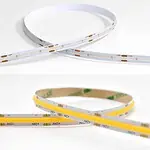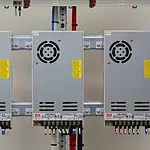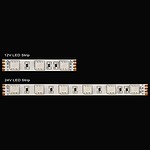The primary input voltage for LED strip lights is 12 Vdc and 24 Vdc, respectively. They are safe and easy to work with. But, we often hear this statement: The LED strip is brighter at one end and dimmer at the other. Why?
The answer is voltage drop. Actually, this is very normal in low voltage lighting systems.
In this article we’ll talk about:
What’s LED strip voltage drop?
LED strip voltage drop refers to the gradual reduction of voltage as electricity flows through the strip and connecting wires. This happens because resistance in the circuit causes part of the voltage to be lost. The longer the wire or strip, the higher the resistance, which can lead to uneven brightness—where one side of the strip is brighter than the other.
To avoid this issue, careful planning of your LED strip installation is essential. Understanding the relationship between wire length, strip length, and power supply placement is crucial for ensuring consistent brightness across your LED strip.
To make this process easier, we offer a Voltage Drop Calculator on our website. This tool helps you determine the optimal setup for your LED strips by calculating the expected voltage drop based on your specifications. Using it can save you time and ensure a balanced, professional-looking result for your lighting project.
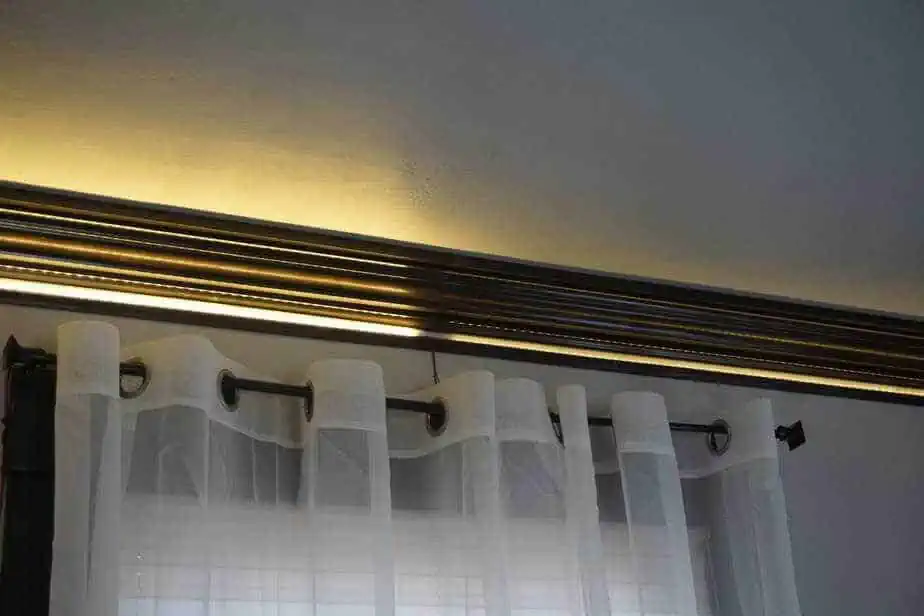
Why LED strip voltage drop happen?
The first reason is any length of wire has a certain amount of electrical resistance. The longer the wire, the more the resistance. Electrical resistance causes a voltage drop, and voltage drop causes your LEDs to dim.
The second reason is the PCB itself has resistance. The resistance of the PCB will consume part of the voltage and convert the electrical energy into thermal energy.
PCB resistance is related to the cross-section size (corresponding to the PCB board width and copper thickness). The larger the PCB cross-section, the smaller the resistance; the longer the PCB length, the greater the resistance.
How to find voltage drop?
The LED voltage drop is most noticeable on the white led strip so you can open the white light on the color-changing led strip to observe the voltage drop.
Let us see if we can see a voltage drop by running a long-distance white light led strip. In the below picture, we can see that the beginning (position “1”) is clear white, and after running for a distance (position “2”), the white light gradually turns yellow, and at the end of the led strip (position “3”), the white light turns red due to the decrease in voltage.
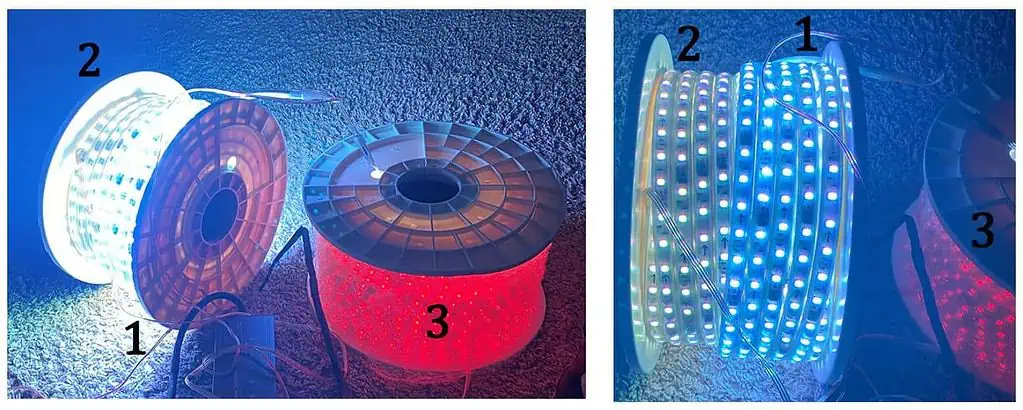
(Reminder: When the led light strip is rolled, it should not be lit for a long time, which will damage the led strip.)
LED strip voltage is related to LED chips. Below are the forward voltages required for several color chip drives.
- Blue LED chip: 3.0-3.2V
- Green LED chip: 3.0-3.2V
- Red LED chip: 2.0-2.2V
Note: The white LED uses a blue chip and then adds phosphors on the surface.
The driving voltage of the blue chips is greater than that of the green and red chips. So when the voltage of the white led strip light drops, and the current voltage cannot meet the voltage required by the blue chips, the light strip will display yellow(green & red mixed color) and red because they are lower than the voltage required by the white light.
Do all LED strip lights have a voltage drop?
Basically, all low-voltage LED strips, such as 5Vdc, 12Vdc, and 24Vdc will have voltage drop problems. Because for the same power consumption, the lower the voltage, the greater the current. According to Ohm’s law, voltage equals resistance multiplied by current. The resistance of a conductor is constant. The greater the current, the greater the voltage drop. This is also the reason why people use high voltage to transmit electricity!
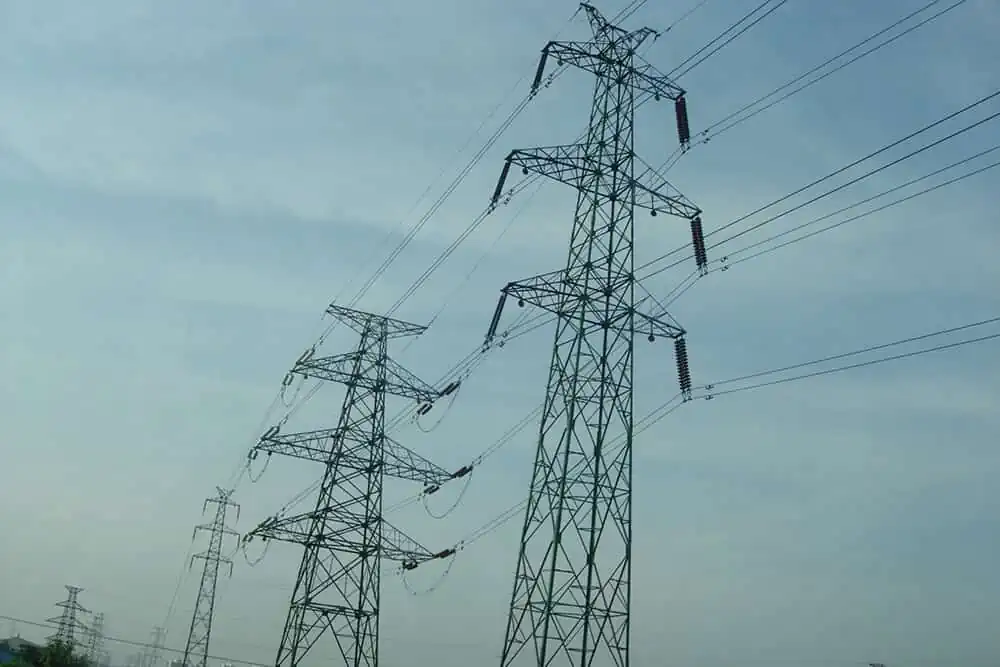
High voltage LED strips, such as 110VAC, 220VAC, and 230VAC, generally do not have the problem of voltage drop. For one end power feed, the maximum run distance of high-voltage LED light strips can be up to 50 meters. According to the power equal to the voltage multiplied by the current, the voltage of the high-voltage LED strip is 110V or 220V, so the current of the high-voltage LED strip is very small, so the voltage drop is also small.
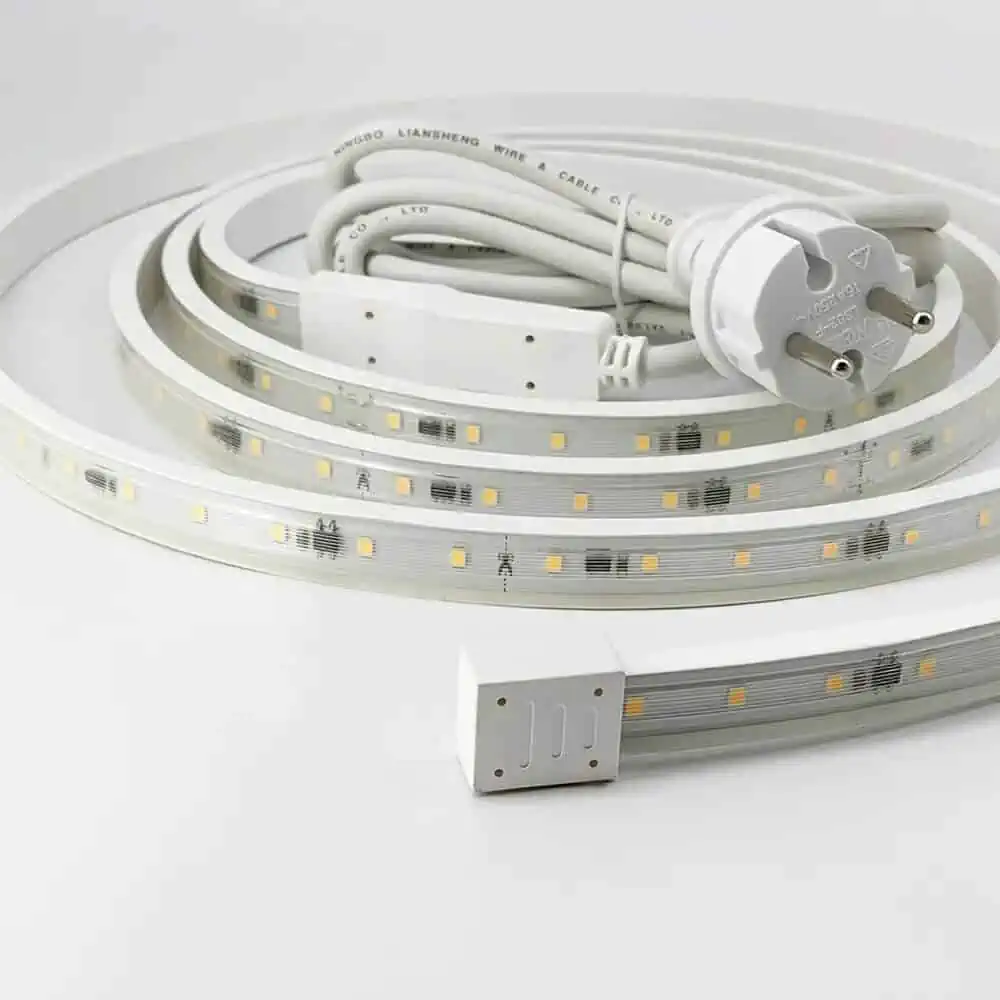
The constant current LED light strip, generally 24Vdc, will not have the problem of voltage drop. Because constant current LED strips have ICs, these ICs can keep the current flowing through the LEDs constant. As long as the current through the LED is constant, the brightness of the LED is also constant.
In fact, the voltage of the constant current LED light will also decrease. For example, the voltage at the end of the constant current LED light strip will also be lower than the 24V. Under normal circumstances, a voltage drop will cause a drop in current through the LED, resulting in lower brightness. However, since there are ICs on the constant current LED strips, these ICs can keep the current passing through the LEDs constant, which needs to be within a specific voltage range (for example, 24V~19V).
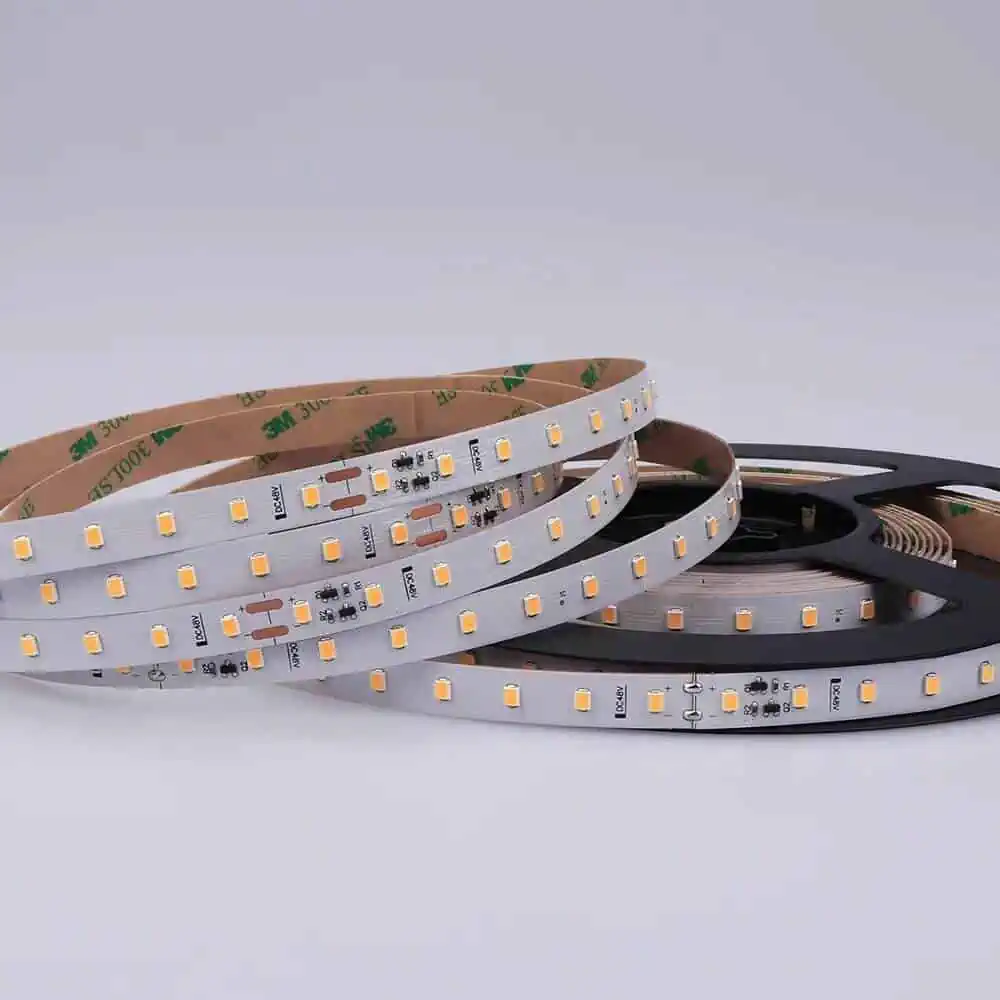
Is LED strip voltage drop harmful?
LED strip voltage drop is typically not detrimental to the LEDs since it is a form where the voltage supplied to them is less than what was originally expected.
However, the voltage drop usually represents the conversion of electrical energy to the thermal energy of the resistor, which generates a lot of heat. This can cause problems if your LED strip is installed in or near heat-sensitive materials. 3M adhesives and LEDs are also somewhat thermally sensitive so excessive voltage drops can be a problem.
What Factors will affect the voltage drop?
According to Ohm’s law, voltage is equal to current times resistance.
The resistance of the wire is determined by its length and size of the wire. The LED strip PCB resistance is determined by the length and the thickness of the copper in the PCB.
So, the degree of voltage drop of LED strips can be determined by the main factors: the total current of the LED strip, the length and diameter of the wire, the length of the LED strip and the thickness of the PCB copper.
The total current of the LED strip
Through the specification of the LED strip, we can know the power of the 1-meter LED strip, so that we can calculate the total power of the LED strip.
The total current of the LED strip is equal to the total power divided by the voltage.
So the greater the total power, the greater the total current, and thus the more severe the voltage drop. Therefore, the voltage drop of LED strips with high power is more serious than that of LED strips with low power.
Alternatively, the lower the voltage, the higher the current and the more severe the voltage drop. Therefore, the voltage drop of the 12V LED strip is more serious than that of the 24V strip.
The length and diameter of the wire
The resistance of the wire is mainly determined by the conductor’s material, the conductor’s length, and the conductor’s cross-section.
The resistance of the wire is mainly determined by the material of the conductor, the length of the conductor, and the cross-section of the conductor. The longer the wire, the greater the resistance, and the smaller the cross-section, the greater the resistance.
You can check out the Wire Resistance Calculation Tool to make calculations more straightforward.
The length and the thickness of the copper in the PCB
PCBs are similar to wires, they are both conductors and have resistance themselves. The conductive material in a PCB is copper. The longer the PCB, the greater the resistance; the larger the copper cross-section inside the PCB, the smaller the resistance.
You can check out the PCB Resistance Calculation Tool to make calculations more effortless.
How to Avoid Voltage Drop?
Although the LED strip will have the voltage drop problem, we can avoid it using the following methods.
Parallel Connections
When longer LED strips need to be installed, it is recommended that every 5 meters of strips be connected to the power supply in parallel.
Power supply at both ends of the led strip light
The recommended maximum length of LED strips on the market is 5 meters. If you need to install a 10-meter LED strip, you can connect both ends of the LED strip to the power supply.
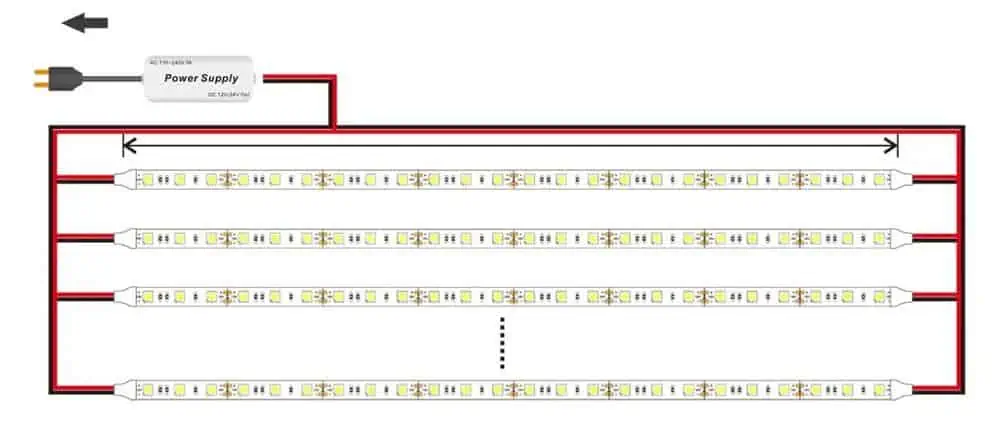
Use multiple power supplies
Using multiple power supplies instead of a single unit is a great idea to get better brightness. It requires strategic planning, so you don’t end up too far from the power source.
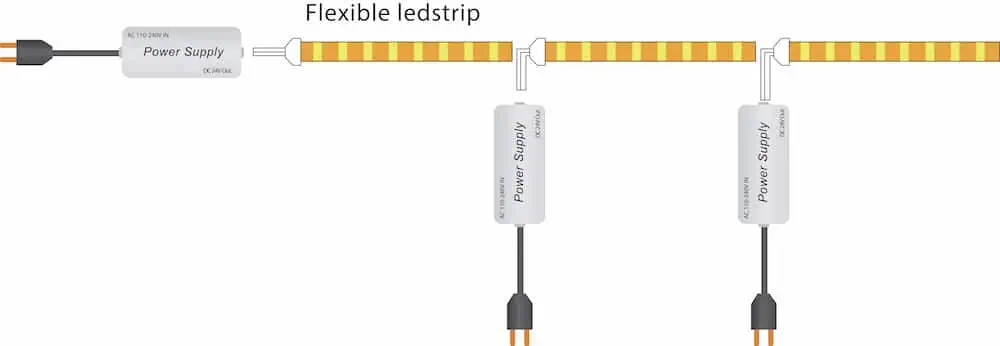
Use high voltage 48Vdc or 36Vdc LED strip
Use higher input voltage LED strips to avoid voltage drop issues.
For example, use 48V, 36V, and 24V instead of 12V and 5V.
Because higher voltage means lower current, lower voltage drop.
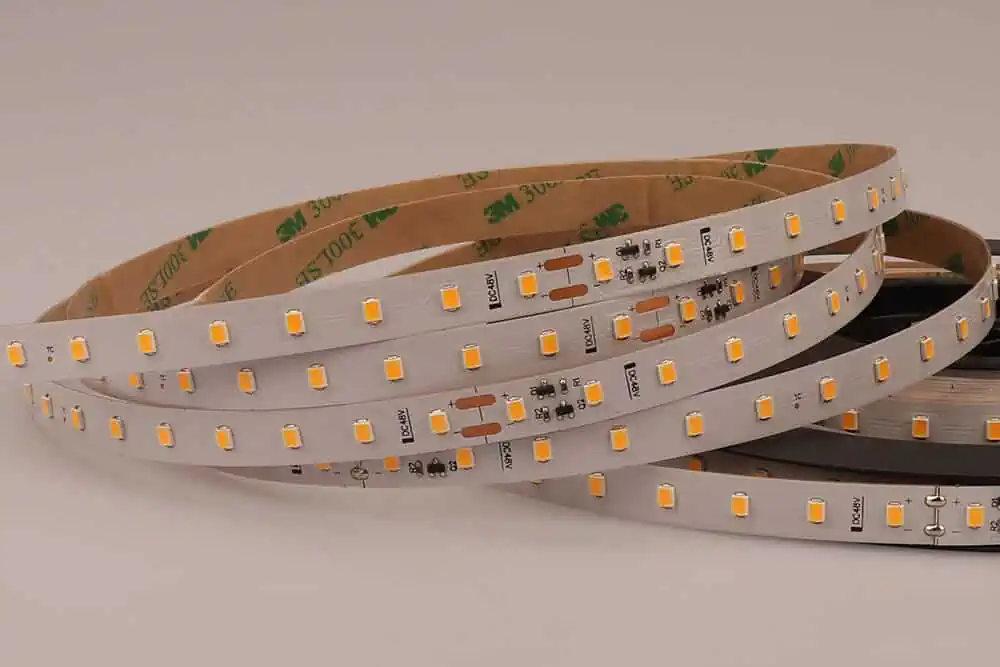
Use LED strips with thick copper PCB
Copper is the most commonly used material in electrical wiring. This is because it conducts electricity well and is relatively inexpensive compared to silver.
The thickness of copper is usually measured in ounces. The thicker the copper wire, the more current flows through.
We recommend using 2oz. or 3 oz. for high-power LED strips to avoid voltage drops.
The thicker the copper wire, the lower the internal resistance.
Therefore, the copper wire will carry more power efficiency.
In addition, it is better for heat dissipation.
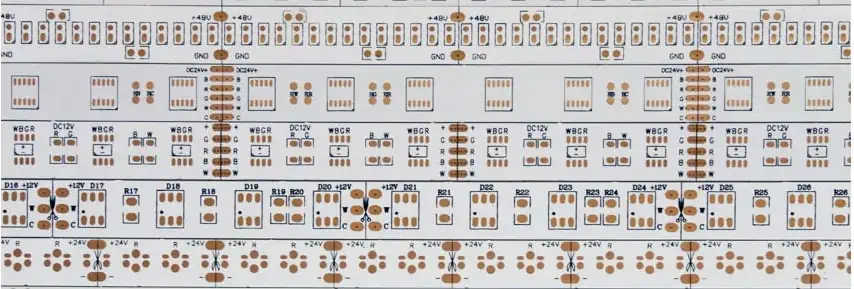
Use big size wire
Sometimes, the place where the LED strip is installed is a long distance from the LED power supply. Then we must consider what size wire we need to use to connect the LED strip and the power supply. Of course, the bigger the wire size, the better. We need to know what the voltage drop is that we can accept, and know what this length of the wire causes the voltage drop.
You can determine the size of the wire by following the steps below:
Step 1. Calculate the Wattage
You can check the power per meter on the packaging label of the LED strip, so the total power is the power per meter multiplied by the total number of meters. Then divide the total power by the voltage to get the total current.
Step 2. Measure the distance between the LED strip and the driver
Measure the distance between the LED strip and the LED power supply. This directly affects wire size.
Step 3. Choose the right size wire
You can calculate the voltage drop of the wire using the Voltage Drop Calculator.
You can try changing different wire diameters in the calculator to see the voltage drop corresponding to different wire diameters.
This way, find a wire of the right size (with a voltage drop you can accept).
Use super long constant current LED strip
The super long constant current (CC) led strip light can achieve 50 meters, 30 meters, 20 meters, and 15 meters per reel, and only needs to be connected to the power supply on one end, and the brightness of the beginning and the end are the same.
By adding constant current IC components to the circuit, the super long constant current led strip can ensure that the current through the LED can be kept constant within a specific voltage range (for example, 24V~19V) so that the brightness of the LED is consistent.


Conclusion
The voltage drop problem can be solved, but it will cost you some time or money. If you want to save money, you can connect the led strips in parallel to the power supply or connect both ends of the led strips to the power supply. If you need to save time, you can choose LED strips with thicker copper PCB or super long constant current LED strips. However, sometimes time is money.
LEDYi manufactures high-quality LED strips and LED neon flex. All of our products go through high-tech laboratories to ensure the utmost quality. Besides, we offer customizable options on our LED strips and neon flex. So, for premium LED strip and LED neon flex, contact LEDYi ASAP!
